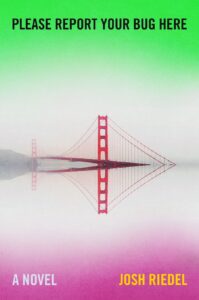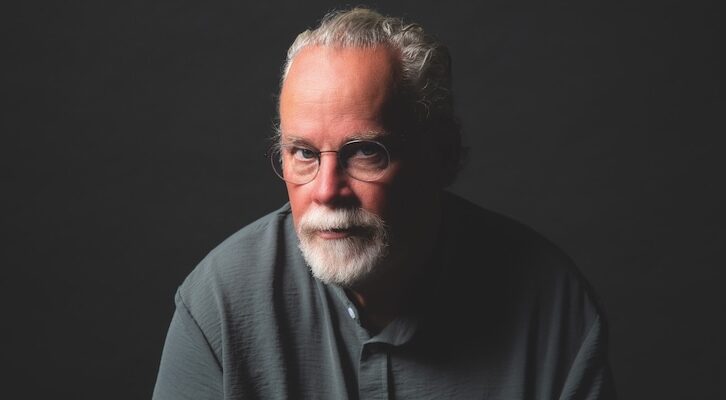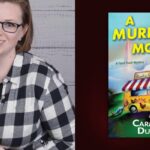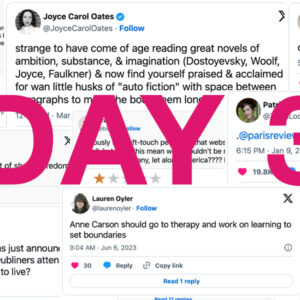
How Leaning into Marginalia Helped Me Accept the Loss of Control That Comes with Publication
Josh Riedel on Doodles, Dogears, and Acceptance
In grad school, I lent a friend my copy of Charles Yu’s How to Live Safely in a Science Fictional Universe. It’s a meta-science-fictional novel about a character named Charles Yu, a time-machine repairman in search of his father. I find myself recommending the book all the time. But I no longer lend out my copy. You see, when my friend returned the book, I discovered that he’d dogeared the pages and made his own notes in the margins alongside mine. I don’t consider myself precious about my books—I like a well-worn edition!—but his notes were distracting.
What’s more, I couldn’t tell who—me or my friend—had dogeared which pages. Yu’s debut novel is one of my favorites, a book I’d already read twice by the time I lent it out, but my own record of what sentences and passages made this novel a favorite was now in flux. I wished for my own time machine so I could travel to the past and not lend out the book.
But last summer, five years after my friend borrowed it, I found myself opening How to Live Safely and skipping around to the sections he’d marked up. “To read another writer’s marked-up copy of a book,” Ander Monson writes in Letter to a Future Lover, “is to read two books at once, text and pretext, the passage and the pilgrim’s progress, to see how an animal takes root and begins to worm inside a brain, even if we don’t get to see its final bloom.” I hadn’t seen or even spoken with my grad school friend in years, but reading the passages he’d highlighted made me feel close to him again. His marginalia collapsed time and space, and I found myself, once again, in intimate conversation with an old friend.
When I took Yu’s debut novel off my bookshelf last summer, I was stuck in a quiet period in the publishing timeline for my own novel. I’d sold my book in late 2020 and had recently submitted the finished manuscript to my publisher, but the publication date was still six months away. What was I supposed to do in the meantime? Eventually, I would meet my publicist and marketing team—but not just yet. For now, my agent advised, I should sit tight. Maybe write something new. Work on essays, a friend told me.
But waiting was tough. January 2023 seemed so far away. I know you’re supposed to enjoy the present, but I can’t say I wouldn’t have jumped into a time machine and traveled ahead six months, just so I could finally trust that my book would actually exist.
His marginalia collapsed time and space, and I found myself, once again, in intimate conversation with an old friend.
Although I didn’t have a time machine, I did have advance copies, and reconnecting with my friend’s notes had given me an idea. I decided to send a few copies of my novel out to friends, a small way to see the book in the world before it officially published. Along with the book, I included an address list so each reader could pass the book along to the next person. The book would function as a kind of chain email, only you probably wouldn’t be cursed if you didn’t pass it along. I encouraged my friends to fill the book’s margins with doodles and notes on where they took the book or what their kids said in the background as they read or what caused that spill on page 67. Anything that offered proof that my book existed in the world.
The plan worked, at least at first. My friends shared photos of themselves reading my novel in hair salons, on the beach, and in cafes. A former coworker and writer-friend in London, Hannah Ray, wrote about her experience reading the book, describing how she “got to know the previous owner through their sweet, cute doodles.” The previous reader was my friend Krish, a cartoonist in Amsterdam whom I met at an artist residency just before the pandemic hit.
I liked how my book pass-along project was bringing together friends from different periods of my life. “I felt like I was getting snippets of their personality and tone…t hrough their penciled annotations and illustrations,” Hannah wrote. “It was, I imagine, a bit like finding a stack of photographs and wondering who took them. I loved knowing we had held and leafed through the same pages. There was no way to communicate back, but I was linked to them.”
The project continued like this for a few months, with friends posting photos on Instagram and Twitter or messaging me about the book. The project helped convince me that yes, one day this book would be out in the world. And it was a fun distraction, one I thought other debut authors might want to replicate. So I set out to write an essay about the project, detailing how I organized it, with photos of my favorite marginalia, like Krish’s doodles and Hannah’s notes. Maybe other authors would want to try something similar. My essay could be a guide!
But when I looked at my list of readers and messaged the person who ought to have had the copy, she told me she’d already dropped the book in the mail. The next reader, however, had not received it. Maybe it was a mix-up on my end, I thought. I messaged another friend and asked her to send me the copy that had been sent to her, but when I received that copy in the mail, I found no doodles in the margins, no notes from Hannah. The copy I was seeking was lost. I had no idea who had which book, or if the books were still in circulation at all. I imagined the copies caught up in a storm of holiday packages, placed on the wrong icy porch or forgotten in the dark corner of a shipping center.
This must be what it’s like to put a book out in the world, I told myself. You lose control. Accept that.
Perhaps because I was in essay-writing mode, I immediately tried to draw conclusions from this experience. This must be what it’s like to put a book out in the world, I told myself. You lose control. Accept that. I imagine, writing this essay two weeks before my novel hits bookstores, there’s some truth in that. Already I know the book belongs to readers now. But as much as I was trying to brace myself for whatever swirl of emotions would hit on publication day, these lessons I told myself about the future mostly amused me, because they brought to mind another passage in Monson’s book, one I’d dogeared years ago.
As he sits in the Science & Engineering library at the University of Arizona, Monson hears the clacking of keys. It’s a graduate student typing at his keyboard in early May. Monson is momentarily impressed with the student’s industriousness, before he realizes the sound is not what he’d assumed. “Investigating closer, the sound becomes inhuman, no typist but a rattling baffle in the air duct…. This is the problem with the future,” Monson writes, “how to use what we think we know right now to lever open an idea into understanding, knowing all the while that this is not knowledge but a best-fit line among the scatter plot in view of what we think we know, and not much of one, at that.”
My book pass-along project helped me see what it might be like to have a book out in the world—but it wasn’t a time machine. Although I could share early copies of the book with friends, that wasn’t the same as actually publishing the book. There’s no skipping ahead in time. The future we know today is nothing but a collection of best-guesses, an imaginary typist in the Science & Engineering library that might turn out to be something else entirely.
In Yu’s novel, the character Charles Yu consults the book How to Live Safely in a Science Fictional Universe as a guide in his quest to locate his father. The dogeared page I find myself returning to most often is actually a page from this guide that the character consults. It reads:
In the book, right at this point, my future self has written these words: There exists a time in which you will have written this book.
In the next paragraph, he goes on: I know none of this seems very believable. It probably doesn’t even make sense. But for once in your life, please, I am asking you to trust me. Trust yourself.
I have no idea which one of us—me or my friend—dogeared this particular page. Maybe both of us did, a reminder to ourselves and to each other—and to you, future author—to trust ourselves. The future comes faster than you think.
_______________________________

Please Report Your Bug Here by Josh Riedel is available now via Henry Holt and Co.
Josh Riedel
Josh Riedel was the first employee at Instagram, where he worked for several years before earning his MFA from the University of Arizona. His short stories have appeared in One Story, Passages North, and Sycamore Review. Please Report Your Bug Here is his first novel. He lives in San Francisco, California.



















